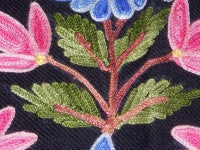Do you buy embroidered apparel? Would you check if it is hand embroidered or machine embroidered before buying? Do you know how to tell the difference between the two? We shall try to point out some differences between hand and machine embroidery that makes it easier to make out the fakes.
Let's start by asking why there are duplicates of hand embroidered apparel in the market in the first place. Well, for the simple reason that machine embroidery costs much less when compared to hand embroidery as it uses a machine to do the embroidery work and achieves larger profits when sold as handmade.


When we see it for the first time, it could be quite hard (or even impossible) to tell the difference between hand embroidery and machine embroidery. Take a look at the pictures of two similar shawls above and try to figure out which one is Hand Embroidered and which one is Machine Embroidered?
Not sure? Here are a few simple visual tests to help you point out the fake (machine embroidered). Before going ahead I also find it worthwhile to include a price comparison between hand embroidered and machine embroidered items in similar types of embroidery:
| Product name | Hand Embroidery cost (US$) | Comparable Machine Embroidery cost (US$) |
|---|---|---|
| Jacket | 125-150 | 30-40 |
| Shawl | 145-165 | 40-50 |
| Coat | 175-210 | 50-60 |
| Poncho | 45-60 | 15-18 |
| Dressing gown | 120-140 | 40-50 |
As you can see the price difference is quite large. A machine embroidered jacket costs roughly 25% of its hand embroidered counterpart, but will sell comparatively higher when it is advertised as a hand embroidered jacket.
A LOOK AT THE REVERSE SIDE: This is helpful only for items which don't have a lining (shawls, sarees, salwar kameez, kurtas). A first look at the reverse side of the garment will reveal clearly if the item is embroidered by hand or machine. Machine embroidery is a continuous stitching process and employs multi-colored thread for embroidery. It therefore has continuity in stitches with very few breaks. Hand-stitch on the contrary employs single-color threads for embroidery and the craftsman from time to time breaks off the earlier thread (color) to start a new thread (color) leaving behind a trail of threads hanging on the reverse side of the fabric.
 |
 |
|
Hand embroidery leaves a lot of threads hanging on the reverse side. |
Machine embroidery leaves very few threads hanging on the reverse side. |
A LOOK AT THE FRONT: This test requires one to have a good understanding regarding familiarity with hand-stitch and machine-stitch.
 |
|
|
Hand embroidery is tidy with good variety of colors. |
Machine embroidery overlaps. |
 |
 |
|
Notice the ascending shoot (brown color) with its curves imparted by skilled hands. |
The shoot (brown color) here is more of a straight line type and overlapping onto the leaves (green color). |
